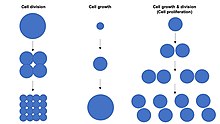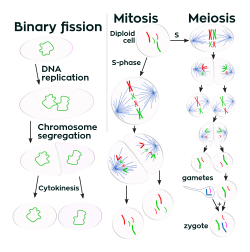Cell growth

| Part of a series on |
| Biology |
|---|
 |
Cell growth refers to an increase in the total
Cell growth is not to be confused with

In
Cell size depends on both cell growth and cell division, with a disproportionate increase in the rate of cell growth leading to production of larger cells and a disproportionate increase in the rate of cell division leading to production of many smaller cells. Cell proliferation typically involves balanced cell growth and cell division rates that maintain a roughly constant cell size in the exponentially proliferating population of cells.
Some special cells can grow to very large sizes via an unusual
Oocytes can be unusually large cells in species for which embryonic development takes place away from the mother's body within an egg that is laid externally. The large size of some eggs can be achieved either by pumping in cytosolic components from adjacent cells through cytoplasmic bridges named ring canals (Drosophila) or by internalisation of nutrient storage granules (yolk granules) by endocytosis (frogs).
Mechanisms of cell growth control
Individual
To drive cell growth, the global rate of gene expression can be increased by enhancing the overall rate of
In addition, the activity of individual
To inhibit cell growth, the global rate of gene expression can be decreased or the global rate of
Cell growth regulation in animals
Many of the signal molecules that control of cellular growth are called
Nutrient availability influences production of
In addition, the availability of
One disputed theory proposes that many different mammalian cells undergo size-dependent transitions during the cell cycle. These transitions are controlled by the cyclin-dependent kinase Cdk1.[7] Though the proteins that control Cdk1 are well understood, their connection to mechanisms monitoring cell size remains elusive.
A postulated model for mammalian size control situates mass as the driving force of the cell cycle. A cell is unable to grow to an abnormally large size because at a certain cell size or cell mass, the S phase is initiated. The S phase starts the sequence of events leading to mitosis and cytokinesis. A cell is unable to get too small because the later cell cycle events, such as S, G2, and M, are delayed until mass increases sufficiently to begin S phase.[8]
Cell populations
Cell populations go through a particular type of exponential growth called doubling or cell proliferation. Thus, each generation of cells should be twice as numerous as the previous generation. However, the number of generations only gives a maximum figure as not all cells survive in each generation. Cells can reproduce in the stage of Mitosis, where they double and split into two genetically equal cells.
Cell size
Cell size is highly variable among organisms, with some algae such as
Yeast cell size regulation
The relationship between cell size and cell division has been extensively studied in yeast. For some cells, there is a mechanism by which cell division is not initiated until a cell has reached a certain size. If the nutrient supply is restricted (after time t = 2 in the diagram, below), and the rate of increase in cell size is slowed, the time period between cell divisions is increased.[10] Yeast cell-size mutants were isolated that begin cell division before reaching a normal/regular size (wee mutants).[11]

Linking Cdr2 to Wee1
The protein kinase
Further experimentation with GFP-tagged proteins and mutant proteins indicates that the medial cortical nodes are formed by the ordered, Cdr2-dependent assembly of multiple interacting proteins during interphase. Cdr2 is at the top of this hierarchy and works upstream of Cdr1 and Blt1.[14] Mitosis is promoted by the negative regulation of Wee1 by Cdr2. It has also been shown that Cdr2 recruits Wee1 to the medial cortical node. The mechanism of this recruitment has yet to be discovered. A Cdr2 kinase mutant, which is able to localize properly despite a loss of function in phosphorylation, disrupts the recruitment of Wee1 to the medial cortex and delays entry into mitosis. Thus, Wee1 localizes with its inhibitory network, which demonstrates that mitosis is controlled through Cdr2-dependent negative regulation of Wee1 at the medial cortical nodes.[14]
Cell polarity factors
Cell polarity factors positioned at the cell tips provide spatial cues to limit Cdr2 distribution to the cell middle. In fission yeast Schizosaccharomyces pombe (S. Pombe), cells divide at a defined, reproducible size during mitosis because of the regulated activity of Cdk1.[15] The cell polarity protein kinase Pom1, a member of the dual-specificity tyrosine-phosphorylation regulated kinase (DYRK) family of kinases, localizes to cell ends. In Pom1 knockout cells, Cdr2 was no longer restricted to the cell middle, but was seen diffusely through half of the cell. From this data it becomes apparent that Pom1 provides inhibitory signals that confine Cdr2 to the middle of the cell. It has been further shown that Pom1-dependent signals lead to the phosphorylation of Cdr2. Pom1 knockout cells were also shown to divide at a smaller size than wild-type, which indicates a premature entry into mitosis.[14]
Pom1 forms polar gradients that peak at cell ends, which shows a direct link between size control factors and a specific physical location in the cell.[16] As a cell grows in size, a gradient in Pom1 grows. When cells are small, Pom1 is spread diffusely throughout the cell body. As the cell increases in size, Pom1 concentration decreases in the middle and becomes concentrated at cell ends. Small cells in early G2 which contain sufficient levels of Pom1 in the entirety of the cell have inactive Cdr2 and cannot enter mitosis. It is not until the cells grow into late G2, when Pom1 is confined to the cell ends that Cdr2 in the medial cortical nodes is activated and able to start the inhibition of Wee1. This finding shows how cell size plays a direct role in regulating the start of mitosis. In this model, Pom1 acts as a molecular link between cell growth and mitotic entry through a Cdr2-Cdr1-Wee1-Cdk1 pathway.[14] The Pom1 polar gradient successfully relays information about cell size and geometry to the Cdk1 regulatory system. Through this gradient, the cell ensures it has reached a defined, sufficient size to enter mitosis.
Other experimental systems for the study of cell size regulation
One common means to produce very large cells is by cell fusion to form
Increases in the size of plant cells are complicated by the fact that almost all plant cells are inside of a solid cell wall. Under the influence of certain plant hormones the cell wall can be remodeled, allowing for increases in cell size that are important for the growth of some plant tissues.
Most unicellular organisms are microscopic in size, but there are some giant
In the rod-shaped bacteria E. coli, Caulobacter crescentus and B. subtilis cell size is controlled by a simple mechanisms in which cell division occurs after a constant volume has been added since the previous division.[19][20] By always growing by the same amount, cells born smaller or larger than average naturally converge to an average size equivalent to the amount added during each generation.
Cell division
Cell reproduction is
The process of cell division, called cell cycle, has four major parts called phases. The first part, called G1 phase is marked by synthesis of various enzymes that are required for DNA replication. The second part of the cell cycle is the S phase, where
Cell division is more complex in
The rest of this article is a comparison of the main features of the three types of cell reproduction that either involve binary fission, mitosis, or meiosis. The diagram below depicts the similarities and differences of these three types of cell reproduction.

Comparison of the three types of cell division
The DNA content of a cell is duplicated at the start of the cell reproduction process. Prior to DNA replication, the DNA content of a cell can be represented as the amount Z (the cell has Z chromosomes). After the DNA replication process, the amount of DNA in the cell is 2Z (multiplication: 2 x Z = 2Z). During Binary fission and mitosis the duplicated DNA content of the reproducing parental cell is separated into two equal halves that are destined to end up in the two daughter cells. The final part of the cell reproduction process is cell division, when daughter cells physically split apart from a parental cell. During meiosis, there are two cell division steps that together produce the four daughter cells.
After the completion of binary fission or cell reproduction involving mitosis, each daughter cell has the same amount of DNA (Z) as what the parental cell had before it replicated its DNA. These two types of cell reproduction produced two daughter cells that have the same number of chromosomes as the parental cell. Chromosomes duplicate prior to cell division when forming new skin cells for reproduction. After meiotic cell reproduction the four daughter cells have half the number of chromosomes that the parental cell originally had. This is the

Immediately after DNA replication a human cell will have 46 "double chromosomes". In each double chromosome there are two copies of that chromosome's DNA molecule. During mitosis the double chromosomes are split to produce 92 "single chromosomes", half of which go into each daughter cell. During meiosis, there are two chromosome separation steps which assure that each of the four daughter cells gets one copy of each of the 23 types of chromosome.
Sexual reproduction
Though cell reproduction that uses mitosis can reproduce eukaryotic cells, eukaryotes bother with the more complicated process of meiosis because
Disorders
A series of growth disorders can occur at the cellular level and these consequently underpin much of the subsequent course in
Measurement methods
The cell growth can be detected by a variety of methods. The cell size growth can be visualized by
Beside the increasing number of cells, one can be assessed regarding the metabolic activity growth, that is, the CFDA and calcein-AM measure (fluorimetrically) not only the membrane functionality (dye retention), but also the functionality of cytoplasmic enzymes (esterases). The MTT assays (colorimetric) and the resazurin assay (fluorimetric) dose the mitochondrial redox potential.
All these assays may correlate well, or not, depending on cell growth conditions and desired aspects (activity, proliferation). The task is even more complicated with populations of different cells, furthermore when combining cell growth interferences or toxicity.
See also
References
- ^ S2CID 15738174.
- PMID 12733996.
- S2CID 14608744.
- PMID 20833011.
- PMID 14560957.
- PMID 35772404.
- )
- PMID 15456512.
- ^ Peplow, Mark (23 March 2005). "Algae create glue to repair cell damage". Nature.com. Retrieved 4 July 2016.
- PMID 21525243.
- ISBN 978-0-7167-3136-8.
- S2CID 4320080.
- PMID 14602073.
- ^ S2CID 4330336.
- PMID 12175809.
- PMID 17140794.
- PMID 15955848.
- S2CID 32571118.
- PMID 25544609.
- PMID 25480302.
- PMID 26573465.
- ISBN 978-92-832-2436-5.
- ISBN 978-92-832-2438-9. Archived from the originalon 2019-10-31. Retrieved 2019-10-31.
- PMID 31495693.
- PMID 29072271.
- PMID 35732645.
- PMID 17460669.
Books
- Morgan, David O. (2007). The cell cycle: principles of control. London: Sunderland, Mass. ISBN 978-0-9539181-2-6.
External links
- A comparison of generational and exponential models of cell population growth
- Local Growth in an Array of Disks Wolfram Demonstrations Project
